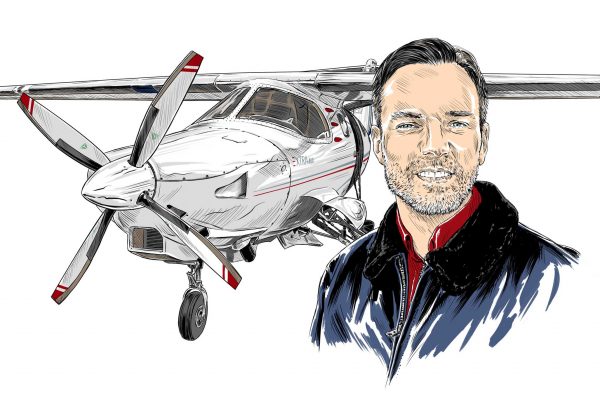Going abroad in a GA aircraft may not be in the forefront of the minds of many people right now, but no doubt some are giving thought to 2022 plans. Since departing the UK invariably involves some passage over water, an obvious consideration is ditching and the appropriate survival equipment.
The applicable regulations are a good starting point. The Part-NCO regulations cover Part-21 aircraft (formerly EASA). For non-Part-21, the Air Navigation Order is similar.
NCO.IDE.A.175 requires that for single-engine aeroplanes, a life-jacket (or flotation device if younger than 24 months) is carried for each person onboard when:
♦ flying beyond gliding range of land, or
♦ taking off or landing at an aerodrome or operating site where, in the opinion of the pilot-in-command, the take-off or approach path is so disposed over water that there would be a likelihood of a ditching.
Be prepared
All aeroplanes must carry life-jackets when operated for more than 30 minutes flying time (at normal cruising speed) or 50nm from land, whichever distance is less.
It is not a regulatory requirement to wear a life-jacket in the aircraft, but it must be readily accessible while seated. Practically speaking, it is sensible to wear the life-jacket, particularly in a single-engine aircraft.
Since 2016, an emergency locator beacon (ELT) has been a requirement for all Part-21 (formerly EASA) aeroplanes, although with up to six passenger seats a portable locator beacon (PLB) can be carried in lieu of this. Personally, I would always take a waterproof PLB that can be activated prior to impact.
In addition to life-jackets, when operating beyond the 30 minutes or 50nm from land, the pilot-in-command is required to assess the risks to survival in the event of a ditching and on that basis, determine the carriage of equipment for making distress signals, life rafts and lifesaving equipment. The associated acceptable means of compliance mentions that factors to consider include sea state, sea and air temperatures, the distance from land and the availability of search and rescue.
Practically speaking you might wonder how to make that judgement. Common sense suggests that in colder temperatures or with a choppy sea state, your chances of survival are less. Also, before using any equipment, you must survive the ditching and escape the aircraft.
Water impact
There is not a huge amount of real-world data to take guidance from, but a brief review of accidents since 2010 involving powered GA aircraft in and around the UK suggests that 18 events involving water impact have occurred, with all but one involving aeroplanes. While a few commercial helicopters have crashed in the North Sea, other than one into a lake due to a misjudged approach, GA helicopters rarely feature – probably because they tend not to venture far from land. About a quarter involved factors such as loss of control and/or continued VFR into IMC. These were typically fatal on impact so carriage of survival equipment would probably not have changed the outcome.
I would say 13 of the 18 were relatively controlled ditchings, most due to engine problems or fuel starvation. Two resulted in fatalities, so most are survivable. The majority occurred within a mile of land and with reasonable weather (probably reflecting typical flying habits), so do not tell us much about post-impact survivability. Curiously four happened in rivers and lakes.
Controlled ditchings on the open seas are rare – only two since 2010 really fitted that description. Both aircraft were carrying life-jackets and rafts. In one case, both occupants managed to vacate the aircraft and enter the raft, in the other the passenger escaped but the pilot did not, despite surviving the impact.
The passenger in the second case was unable to inflate the raft, although the raft pack floated and may have helped rescuers visually locate her. Either way, the water impact is always going to be violent – do you know what technique your POH recommends?
Multiple occupants
Thinking through how to exit the aircraft is also important, especially if you have multiple occupants using one door.
We do know that sea temperatures around the UK are not favourable for survival in the water. The CAA’s Safety Sense Leaflet on ditching suggests that an hour might be typical, unless wearing a survival suit. The sea is typically warmest in September and coldest in March. Experience involving people in very cold water shows that loss of normal body movement can occur in minutes, even if you are a strong swimmer. There is no ready data on how long rescue will take, but it could be significant, especially if the weather is poor. When suffering from hypothermia, death can still occur after being rescued.
The cold water survivability issue suggests most flights leaving the UK should carry a raft, since it will hopefully allow you to get out of the water. Ideally one with a canopy and sea drogue to prevent drifting. Thinking through the best way to deploy the raft will increase the chances of being able to use it – in real scenarios rafts may blow away or deploy upside down. Particularly in winter and spring, an immersion suit may be prudent, since a raft could be lost in the impact or unusable for some reason.
Like many risks in aviation, a degree of worst case scenario thinking is required, even if it’s not a particularly pleasant thought when trying to plan lunch in L2K.
Click here for more info.




